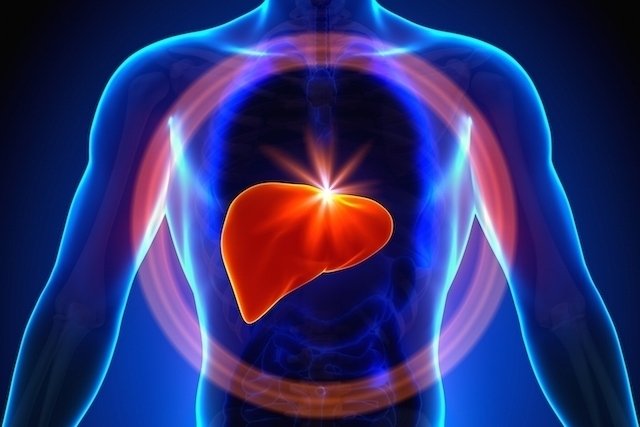Hepatitis C is an inflammation of the liver caused by the Hepatitis C virus, HCV, which is transmitted mainly through sharing syringes and needles for injecting drug use, personal care, tattooing or piercing.
HCV infection can lead to both acute and chronic clinical manifestations. Therefore, people infected with this virus may not show symptoms for years or symptoms of disease progression, such as yellow eyes and skin, which indicate that the liver is more compromised.
Hepatitis C rarely cures itself and therefore treatment with medication is always recommended. Although there is no vaccine against hepatitis C, transmission of the disease can be avoided by using a condom in all sexual relations and avoiding sharing needles and syringes.

Hepatitis C symptoms
The main symptoms of hepatitis C are:
- Fever;
- Nausea;
- Loss of appetite;
- Abdominal, muscle and joint pain;
- Dark urine;
- Clear stools;
- Yellowish color of the skin and eyes;
- Pain in the upper right region of the belly;
- Excessive tiredness;
- Swollen belly.
In general, people infected with the hepatitis C virus do not develop symptoms, so the person may be a carrier of the virus without knowing it. However, in some cases, symptoms may appear up to 45 days after infection.
If any of the symptoms appear, it is important to consult a general practitioner so that a diagnosis can be made and the most appropriate treatment can be indicated to alleviate symptoms and promote the elimination of the virus from the body.
Don’t ignore the signs your body is giving you!
Online symptom test
To find out your risk of having hepatitis, select the symptoms you present in the test below:
The symptom test is only a guidance tool and does not serve as a diagnosis or replace consultation with an infectious disease specialist or general practitioner.
How the diagnosis is made
The initial diagnosis of hepatitis C is made by the general practitioner or hepatologist based on the evaluation of the signs and symptoms presented by the person, in addition to blood tests that allow identifying the presence of the virus in the blood and, thus, confirming hepatitis and its cause. type.
Furthermore, to assess the severity of the infection, the doctor may recommend that imaging tests be carried out, such as an abdominal ultrasound to observe the characteristics of the liver, and the measurement of liver enzymes in the blood, such as TGO and TGP, which assess the functioning of the liver. organ and, according to its levels, it is possible to indicate the person’s risk of developing complications such as cirrhosis or liver cancer, for example.
Read too: Tests to evaluate the liver: blood, imaging and biopsy
Transmission of hepatitis C
The main ways of transmitting the hepatitis C virus are:
- Contact with blood or secretions from contaminated people, such as semen or vaginal secretions, during unprotected sexual intercourse;
- Sharing of syringes and needles used for tattoos, piercings or administering injectable drugs, for example;
- Sharing razors, toothbrushes or manicure or pedicure tools;
- Blood transfusion before 1993, since during that period blood testing for the hepatitis C virus was not yet carried out;
- During childbirth, however, this situation is rarer.
To avoid the transmission of hepatitis C, it is important to use condoms in all sexual relations, not share personal use materials and require the use of disposable materials when performing tattoos, piercings and manicures, for example.
How the treatment is carried out
Treatment for hepatitis C must be guided by a hepatologist, general practitioner or infectious disease specialist and consists of the use of antiviral medications such as Interferon, Daklinza and Sofosbuvir, for example, for approximately 6 months.
However, if the virus remains in the body after this period, the person may develop chronic hepatitis C, which is closely linked to cirrhosis and liver cancer, requiring other treatments, such as a liver transplant.
Furthermore, nutrition is very important and helps keep the liver healthy, preventing complications from hepatitis C, such as cirrhosis. See the following video for some tips on nutrition for hepatitis:
Bibliography
- DOCTORS WITHOUT BORDERS. Hepatitis C. Available at: <https://www.msf.org.br/o-que-fazemos/atividades-medicas/hepatite-c>. Accessed on 11 Jul 2019
- MINISTRY OF HEALTH. Hepatitis C. Available at: <http://www.aids.gov.br/pt-br/publico-geral/o-que-sao-hepatites/hepatite-c>. Accessed on 11 Jul 2019
- FIOCRUZ. Hepatitis C: symptoms, transmission and prevention. Available at: <https://www.bio.fiocruz.br/index.php/hepatite-c-sintomas-transmissao-e-prevencao>. Accessed on 11 Jul 2019

Sign up for our newsletter and stay up to date with exclusive news
that can transform your routine!
Warning: Undefined array key "title" in /home/storelat/public_html/wp-content/plugins/link-whisper-premium/templates/frontend/related-posts.php on line 12
Warning: Undefined array key "title_tag" in /home/storelat/public_html/wp-content/plugins/link-whisper-premium/templates/frontend/related-posts.php on line 13




